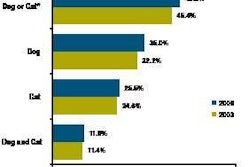
Behavior is regulated by neurotransmitters and hormones, and changes in the availability of their precursors may influence behavior. But unfortunately, the effects of nutrients on behavior are largely unknown. Following are examples of dietary nutrients most likely to have an effect on canine behavior:
- Phytoestrogens, found primarily in soy, may decrease anxiety but increase aggression;
- Antioxidants may lessen age-dependent cognitive decline in dogs;
- Tryptophan may decrease canine aggression and fearfulness.
Preventing euthanasia
At present, few studies have been conducted to evaluate the role of nutrition in canine problem behavior. But studies that explore this relationship may help improve the welfare of dogs and their owners.
Polyunsaturated fatty acids (PUFA), especially docosahexaenoic acid (DHA), have an important role as structural constituents in brain development. Dietary supply of omega-3 and omega-6 PUFAs could modify aspects of the dopaminergic and serotonergic systems and, consequently, cognitive performance and behavior.
Finally, persistent feeding motivation between meals can increase stereotyped behavior and aggression and decrease resting time. This feeding motivation may be decreased by the dietary fiber content of the diet.
Diet and mood changes
Nutrition and behavior are not usually considered to be closely related, but there are key areas of overlap between these fields. Behavioral factors determine the choice of foods in the diet, and any attempt to change dietary patterns must necessarily involve the central nervous system and may be associated with mood changes.
That diet influences behavior is an ancient human belief. Primitive people attributed friendly and unfriendly feelings to plants and animals and expected these feelings to be transferred to anyone who ate such foods. The reduction of dietary risk factors for chronic disease and the development of effective means to do so are key to good health.
Eating disorders in humans
Although infants do not begin life with a choice of foods, some of the most obvious reflexes at birth are those associated with eating. Infants learn to associate eating with security and relief from anxiety, tension and distress. Later, children eat in conformance to cultural and familial standards. Ingrained meanings attached to the roles of food in society suggest reasons that food habits can be changed only with difficulty.
Food selection includes multiple environmental, cultural, genetic, social and sensory variables that interact in complex ways. One exception appears to be an innate preference for foods that are sweet. This preference is acquired in early childhood and continues throughout life.
Selection of foods for nutritional or health reasons is a learned behavior. Infants do not have an inborn ability to select a balanced, nutritious diet. The variety of foods available has an important effect on food consumption; the more the available foods are varied, the more of them people will eat.
Reducing risk for pets
Behavior change is a key element in reducing the risk for chronic disease. Eating behaviors are acquired over a lifetime; to change them requires alterations in habits that must be continued permanentlybeyond any short-term period of intervention.
For humans, dietary advice is often restrictive and viewed as depriving. It may also be incompatible with cultural or familial standards. Environmental factors such as peer pressure, advertising of high-calorie foods and alcoholic beverages may strongly counteract recommended changes.
Despite these difficulties, considerable evidence supports the effectiveness of nutrition education in changing dietary intake. These changes can reduce risk factors for many conditions, and the same can be true for pets.



.png?auto=format%2Ccompress&fit=crop&h=167&q=70&w=250)











